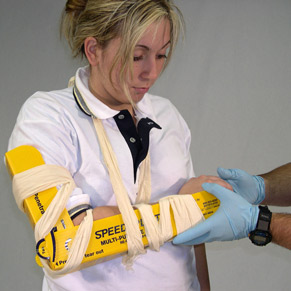Standard First Aid provides comprehensive training covering all
aspects of first aid and CPR. Standard First Aid incorporates all
of Emergency First Aid and is designed for those who require a more
in-depth understanding of first aid including: legal implications
of first aid treatment, spinal injuries, heat or cold injuries,
bone and joint injuries, chest injuries, and medical emergencies.
Includes CPR-C certification.
The first aid program is not restricted to aquatic candidates.
You can use the Lifesaving Society's first aid awards to train
non-aquatic staff (camp, playground, maintenance, etc.) and the
general public.
Prerequisite: None.
Instruction & certification: Current First
Aid Instructors teach Standard First Aid, but only current First
Aid Examiners may certify candidates. The Lifesaving Society deems
its certifications to be "current" for 24 months from the
certification date.
Candidate recognition: Certification card.
Required reference material: Canadian First
Aid Manual or Canadian Lifesaving Manual
:::

Recertification: Complete Standard
First Aid course.
at-a-glance
Standard First Aid includes the ten Emergency
First Aid items in addition to the following:
- Demonstrate two-rescuer adult, child and infant cardiopulmonary
resuscitation on a manikin.
- Demonstrate the recognition and care of a victim with a
suspected spinal injury on land.
- Demonstrate the recognition and care of a victim suffering
from:
- heat cramps, heat exhaustion, and heat stroke
- hypothermia and frostbite
- Demonstrate the recognition and care of a bone or joint
injury.
- Demonstrate the recognition and care of a chest injury.
- Demonstrate the recognition and care of a head injury.
- :::
- Demonstrate the recognition and care of a seizure victim.
- Demonstrate the recognition and care of a diabetic
emergency.
- Demonstrate the recognition and care of a victim suffering from
suspected poisoning.
- Demonstrate an understanding of the effects of stress on
victims, rescuers, and bystanders, as well as the consequences of
an unsuccessful rescue.